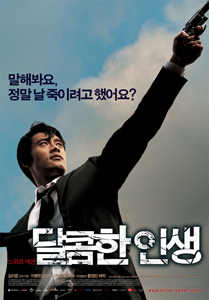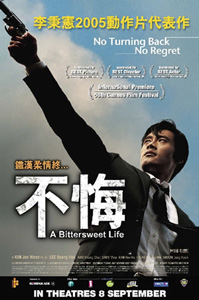![]()
![]()

![]()
![]()
(aka "Dalkomhan insaeng" )
directed by Ji-woon Kim
South Korea 2005
It was easy to be impressed by Ji-woon Kim’s previous
feature, “A Tale of Two Sisters”, as it was an intelligent, haunting and
beautifully crafted horror film. However, after watching “A Bittersweet
Life”, my expectations were not only met, but exceeded, as it is one of the
most impressive Korean films I’ve seen in recent years.
Sunwoo is the right hand of a major gangster, functioning as a hotel
manager. One day his boss, Kang, asks him to look into, if his girlfriend is
seeing another man. Discovering she is, Sunwoo is about to kill them both,
but suddenly decides to solve the problem differently. When Kang learns
about this, he orders Sunwoo killed.
A seminal gangster film, the core of “A Bittersweet Life” is universal in
narrative and structure. It could have been made by Suzuki, it could have
been made by Mann, it could have been made by Hodges. The story can be
transposed into any period or country, and still maintain its strength and
motives.
The two classical elements to this story is first, that Sunwoo makes one
mistake, which leads to his “downfall”, here to show mercy, the second to,
as an abstraction, to rise from the dead and to take revenge. Kim twists the
motif so that Sunwoo is wronged in a way only killing everyone can revenge.
While he did make a mistake, it was a decision of the heart, which could be
forgiven and could have worked out, if not Kang also made a decision of the
heart, namely to kill Sunwoo, because he himself was sick of jealousy and
felt betrayed. Creating this revenge motif, the actions of Sunwoo are
similar to for instance Michael Kohlhaas by Kleist. Comparing the revenge
motifs to the films of Park, the revenge is here single-minded and next to
nihilistic.
What further elevates this film is Kim’s mise-en-scene. The world of Sunwoo
is geometrical and perfect. Clean lines, white shirts, defined architecture
and decoration. It is a world of order. Opposite to this, the world after
the downfall is gritty. The spotless world is replaced with industrial
settings, rain, mud and back alleys. Here the film resembles the work of
especially Michael Mann, who also sets up a perfect world to camouflage the
less perfect world of being a gangster.
“A Bittersweet Life” is a gangster film worth comparing to “Point Blank”,
“Get Carter” and “Thief”. The cinematography is breathtaking, the violence
is beautifully choreographed and very brutal, the use of the genre extremely
intelligent. Kim shows not only insight into the genre, but a love to it, by
paying homages to Suzuki, Woo, Hitchcock, Melville, De Palma, Mann and
Hodges, to name a few. “A Bittersweet Life” is a classic.
Posters
 |
 |
Theatrical Release: April 1st, 2005
Reviews More Reviews DVD Reviews
DVD Review: Tartan - Region 0 - PAL
Big thanks to Henrik Sylow for the Review!
| DVD Box Cover |
|
CLICK to order from:
|
| Distribution |
Tartan Region 0 - PAL |
|
| Runtime | 1:53:57 (4% PAL speedup) | |
| Video |
2.35:1 Original Aspect Ratio
16X9 enhanced |
|
|
NOTE: The Vertical axis represents the bits transferred per second. The Horizontal is the time in minutes. |
||
| Bitrate |
|
|
| Audio | 2.0 Dolby Digital Korean, 5.1 Dolby Digital Korean, DTS Korean | |
| Subtitles | English, None | |
| Features |
Release Information: Studio: Tartan Aspect Ratio:
Edition Details: Chapters 16 |
|
| Comments |
A
flawless transfer. While zooming in to 400%, some colours tend to
blend, this is not recognizable at regular viewing. No visible
artefacts, strong colours, deep blacks, rich details. Just beautiful
to watch. The sound comes in standard three formats, and its superb. Great separation, deep sub, crystal clarity, and excellent use of rears and surround in general. The additional material consists first of an interview section, where apart from some backslapping, Woon offers a little insight to the film. Following is a section about the film at Cannes, and the theatrical trailer. |
DVD Menus
|
|
|
|
|
|
Screen Captures
Subtitle sample - Capture is resized from 1016px to 800px
|
|
|
|
|
|
|
|
|
|


















